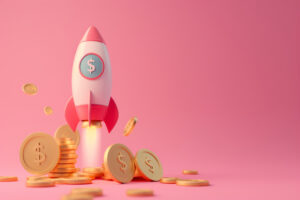Product Management Trends in 2024
The world is constantly changing, and along with it, users’ habits, needs, and expectations from digital products change as well.
A slowing economy, market saturation with look-alike products, increasing number of cyber attacks, ubiquitous AI – all these and other factors impact what products the world will desire and love in the near future.
I have studied research from Accenture, McKinsey, and Ipsos to identify trends in society and technology, and analyzed how they could potentially influence the development of digital products in 2024.
Of course, there are many more trends in society and technology, with AI permeating every niche. However, in this article, I will cover the top 5 trends which I found interesting:
- Trend 1: Unpredictable user segmentation and hyper-personalization
- Trend 2: Growing subscription fatigue
- Trend 3: Saturation with look-alike products and the battle for attention
- Trend 4: Cybercriminals are becoming stronger, now with the support of AI
- Trend 5: Finding the right balance between users’ needs and investors’ demands
Trend 1: Unpredictable user segmentation and hyper-personalization
“I did literally all of the things I was told to do to be successful, and yet I still lack stability on so many levels”
“I keep feeling like my life is about to get started, much like how I felt at 20, even though I’m 40.
-these are the quotes from The New York Times article about the lives of millennials.
Why do millennials feel this way? Because their most active years have passed in quite turbulent times: crises, wars, a pandemic, etc.
Gen-Z, observing millennials, seems to understand that the traditional well-established paths in life no longer guarantee success. The conventional scenario of school, university, a stable long-term job, starting a family, and owning a house does not ensure stability and success.
Due to the high level of uncertainty in the world, the planning window is shrinking. Life milestones are changing and they manifest differently for each individual.
It is becoming increasingly difficult to segment users based on behavior, and almost impossible based on demographic characteristics.
Simply knowing a customer is 64, female, and lives in Sydney will never again be enough to support useful predictions. And make no mistake: people’s expectations of personalised offerings will only grow. – Accenture
In addition, there is a growing expectation that in a world overloaded with information, products should have a better understanding of users and offer increasingly personalized experiences. It appears that with the democratization of AI, we are entering a new era of personalization, where products will be expected to adapt to each individual.
How does this impact product development?
→ Review your segmentation, persona, and marketing strategy
As people are choosing non-traditional lifestyles more often, demographic segmentation is becoming increasingly complex. Therefore, it is necessary to review the segments and personas of your product and segment them by behavior or lifestyle rather than demographics. Additionally, it may be necessary to review the marketing strategy to ensure it aligns with the new priorities and life situations of your target audience.
→ Seek opportunities to personalize product experience
It’s a no-brainer that products that successfully integrate AI for product personalization and marketing will lead the competition, as they will be able to understand customers on a deeper level and provide them with tailored solutions. However, to create personalized experiences, user data is necessary. It is important to clearly explain why you are collecting user data and obtain their consent. While personalization is desired, it should not be based on data that users have unwillingly shared.
Trend 2: Growing subscription fatigue
Product teams are increasingly offering subscriptions even when it doesn’t make sense. For example, how do you like the idea of a subscription for heated front seats (£15 per month) and wheels (£10 per month) in a BMW? Although the subscription was not launched, it raised concerns.

Source: Unsplash.com
Even products that traditionally relied on advertising, such as Twitter and Instagram, are now offering subscriptions. As a result, people accumulate multiple subscriptions, leading to a significant recurrent payment. This has caused irritation, and now, people carefully consider which subscriptions they truly need.
“Once hailed as a source of recurring revenue, subscriptions are becoming tedious to customers, and uptake is slowing down worldwide” Accenture states
User behavior patterns are starting to change: people subscribe and unsubscribe to services as needed. Interesting series came out on Netflix? Let’s subscribe. Is it over? Let’s unsubscribe. That’s why Netflix doesn’t make foolish moves and doesn’t offer a 50% discount on the next month’s subscription when a user tries to unsubscribe.
How does this trend impact product development?
→ More effort is needed to familiarise users with the product
In a saturated market of subscription-based digital products, it is crucial to allow users to try your product before committing to purchase or installation. This can be done through web versions, product demonstrations on social media, and more. Subscribing and installing an application now signify long-term commitments rather than just testing the product, so try to find other ways how to introduce your product to your target audience.
→More control over subscriptions will help acquire and retain users
Services like Netflix and Spotify simplify subscription management, allowing users to easily enable or disable subscriptions without deleting their accounts. Some services even offer freemium mode, enabling continued use after unsubscribing. This helps users maintain control over their finances and reduces resistance to subscriptions.
→ Think twice if you want to use special offers when a user decides to unsubscribe
A checklist for successful e-commerce tactics often recommends offering a discount to users who unsubscribe. But is it effective in your case? If a user unsubscribes because they find the subscription expensive, what do we hope to achieve by giving them a 50% discount for the next month? Will they suddenly become wealthy? Will we provide them with product value for a month? Will they create new accounts and exploit the system to get a discount every time?
For instance, Netflix doesn’t provide any discounts; instead, they suggest taking a one-month break, which works well for them.
→ Review the monetization of your product and make sure it is working in the current realities
Products with customizable subscriptions and alternative payment methods will have an advantage over competitors. In 2023, Netflix introduced a cheaper subscription format with advertising to reach a wider audience. Initially, Netflix resisted adopting an advertising monetization model but eventually did so.
From the Variety interview (2020) with Reed Hastings (co-founder Netflix):
[Interviewer]: You say you’re running a company with no rules. But you do have rules, right? One principle you’ve never wavered on is to not introduce advertising. Isn’t that a rule made to be broken?
[Reed]: It’s definitely not a rule. It’s a judgment call… It’s a belief we can build a better business, a more valuable business [without advertising].
Trend 3: Saturation with look-alike products and the battle for attention
Easy access to business knowledge, the rise of no-code solutions, component libraries, and artificial intelligence have made it easier for more people to create their own digital products.
In the pursuit of reducing time-to-market, creativity has taken a backseat, resulting in many similar solutions.

Source: Inc.com
According to 2024 Accenture’s research on digital trends, 35% of respondents find app designs indistinguishable across brands, a sentiment that rises to nearly 40% among 18-to-24-year-olds.
This is made worse by the constant increase in the number of apps. In our post-mobile-first era, businesses no longer need to be convinced to make websites or products that work well on mobile devices. Almost every service has its app, even if it’s not needed at all.
The battle for users has shifted from Retention to Acquisition. New applications struggle to convince users to download and try them, let alone ensure their continuous return. According to a study published in Forbes by Heady.io, 91% of people dislike constantly being forced to download new apps.
How does this trend impact product development?
→ Review your Go-to-Market strategy
Due to market saturation with look-alike digital products, the popular product-led growth (PLG) business model, which relies on the product as the main factor for attraction, conversion, and growth, seems to take a backseat in the near future. Products that focus on Marketing Led Growth (MLG) – a business model in which marketing is the main driver, will have a greater chance of success in 2024. Brand marketing and social media will become almost key tools for promotion. In 2022-2023, products that invested in creativity and marketing were ahead of their competitors. For example, Duolingo and its TikTok strategy which allowed it to become the top-of-mind app for learning foreign languages.
→ Review your product team and approach to roadmapping
The classic product triad – product manager, designer, and developer, can turn into a quartet with the addition of a marketer. Alternatively, the product manager can become a marketer, as we observed in the case of AirBnb in 2023. Additionally, product roadmaps may include numerous marketing features specifically aimed at creating viral marketing moments.
→ Invest in creativity and move away from template solutions
In a world of look-alike products with uniform designs, people more than ever want something new and creative. Accenture recommends allocating a budget for creativity in 2024 and striving to avoid an approach to product development that is solely focused on efficiency.
Trend 4: Cybercriminals are becoming stronger, now with the support of AI
Some alarming statistics: If cybercrime were a separate country, its total damage of $8 trillion by 2023 would make it the third-largest economy in the world. Hacking and cyber attacks will likely continue to increase.
AI only adds fuel to this fire. For example, its recent achievement of bypassing KYC(remote user verification through photo) has stirred up controversy.

People, it seems, have lost hope and no longer doubt that their data will be leaked online.
55% of respondents in the Ipsos study on trends in 2024 say they believe that their data will likely be leaked online.
In the Deloitte study, we see that trust in digital products is declining:
In 2021, 49% of respondents answered positively to the question of increased trust in online services in protecting their data compared to the previous year. In 2023, this percentage decreased to 38%.
So the loss of hope is mostly based on users’ distrust of digital products, which can be fixed with the right amount of investment into privacy, security, and marketing.
In the same Deloitte study, we also see that people are taking more precautions to protect their data. For example, they are using two-factor authentication, purchasing devices that do not track location, and using VPN and other means. People are arming themselves.
How does this affect product development?
→ Avoid collecting unnecessary user data
Just don’t do it. It raises a lot of concerns.
According to the McKinsey 2022 study, 87% of respondents consider reputation, ethical principles, and the amount of personal data collected by the product to be almost as important factors in making a purchasing decision as cost (94%) and convenience (92%).
→ Make sure to invest in product security
The increasing number of cyber crimes and people’s awareness of online dangers create a need for secure products that proactively care for their users. It appears that investing in security features and incorporating them into your marketing can be an effective strategy to distinguish yourself from competitors soon.
Trend 5: Finding the right balance between users’ needs and investors’ demands
In a slowing economy, investors aggressively seek profitability. To meet investors’ profit expectations, products raise subscription fees and decrease development investments. However, reducing the developer workforce can result in more bugs, security risks, and a decline in product quality, updates, and new features. As a result, customers end up with a poorer product at the same or higher price. This phenomenon known as shrinkflation starts spreading in the tech industry.

Source: Unsplash.com
How does this trend impact product development?
→ Explore your customer ‘forgiveness elasticity’
Accenture now suggests studying users’ “elasticity of forgiveness” to understand what users can tolerate and what can potentially influence them to leave.
Poor customer support and declining product quality can make customers feel undervalued:
According to the Accenture survey, 47% of respondents identified poor customer service as the main reason why they do not feel valued, while 37% cited decreasing product quality as the main reason.
Factors such as ethical practices and data breaches can influence users to discontinue their relationships with your product.
McKinsey research says that 14% of all respondents stopped doing business with a company because they disagreed with its ethical principles, and 10% did so because they learned of a data breach, even when they didn’t know if their own data had been stolen.
The world as well as digital product development is rapidly evolving due to changing user habits, needs, and expectations. To stay ahead, product managers and teams must adapt to emerging trends and challenges.
To summarise, it seems like to stay ahead of competitors and keep users and investors happy, product teams should prioritize creativity in their marketing strategies, invest in security features, and address user fatigue caused by subscriptions and an abundance of apps. Additionally, it is important to re-assess whether the product team still understands the ever-changing needs of their users and adjust marketing and product strategies accordingly focusing on personalized experiences.
Good luck building products people love –– seems like it’s going to be fun in 2024!
This article was originally published by Daria Beliakova on Hackernoon.












